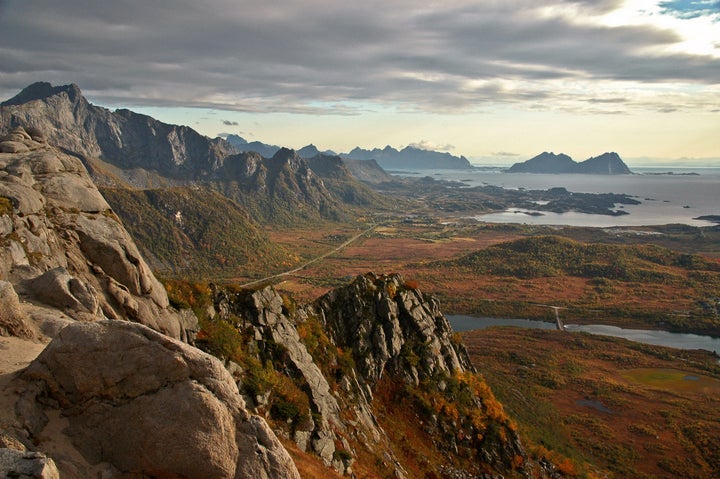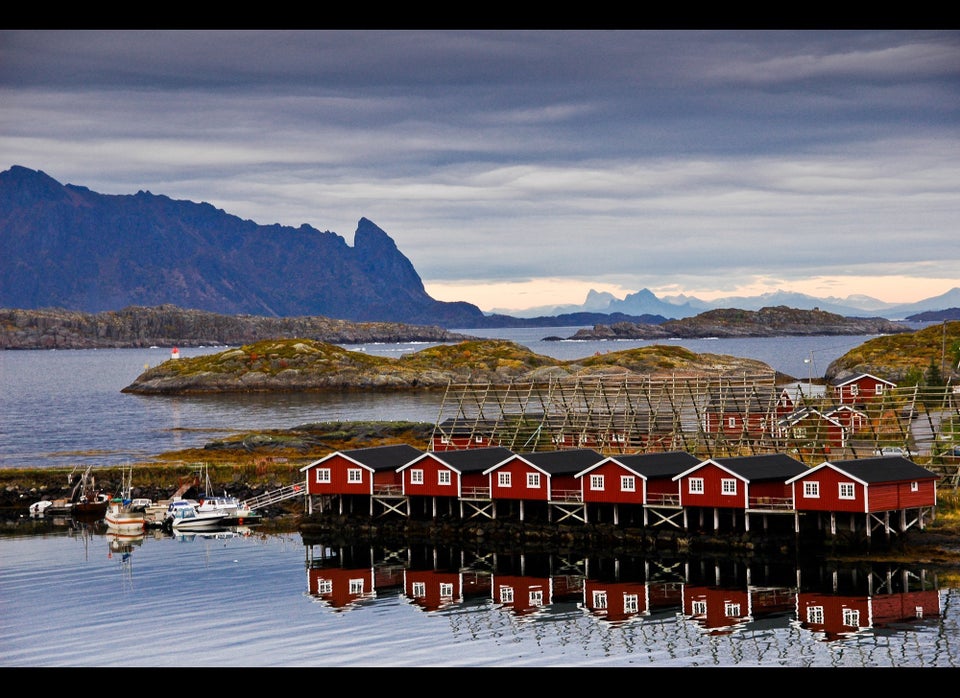
By all latitudinal logic I should be freezing as I launch my ocean kayak into the translucent waters of the Norwegian Sea. Deep inside the Arctic Circle - I'm at the same latitude as Baffin Island -- one expects to encounter icebergs and polar bears, not jellyfish, golf courses and sandy surfing-friendly beaches.
Only the lone ptarmigan circling high overhead makes geographic sense.
I'm soon overheating inside my dry suit trying to navigate the choppy channel between two of the dozens of unspoilt islands that make up the Lofotens, an archipelago off Norway's northwest coast. World renowned for its staggering natural beauty and enormous variety of bird life, the Lofotens also played a vital role as the historic epicenter of Europe's thousand-year-old cod fishery.
An Eco-Friendly Outpost
Warmed by the Gulf Stream, which keeps much of the Norwegian coastline ice-free year round, this climatic anomaly is one of Europe's few remaining wild wonders. Besides climbing the famed "Lofoten Wall" -- an unbroken granite backbone of steep, snow-capped peaks rising straight out of the ocean, adventurous travelers can sea kayak up fjords and between islands, or hike and cycle along sheltered inlets rimmed by sheep pastures streaked with riotous foliage. Then pause to refuel in charming fishing villages that evoke the textures of a 19th century landscape painting.
"Do you know why so many artists live in the Lofotens?" asks Jann Engstad, my paddling partner, as we beach our kayaks in a sheltered cove and hike inland through patches of heather. Stopping to pick wild blueberries under a teal-tinted canopy of arctic sky, equal parts magical and menacing, he answers his own question: "It's because of the mystical quality of the arctic light."
A wooden boat builder by trade, Engstad has operated his own ecotourism business for over 25 years in the Lofotens, where he was born, raised and can count over 500 relatives. In his late fifties, Engstad still regularly leads weeklong kayaking circumnavigations of the archipelago, as well as multi-day hiking and backcountry skiing tours across it in winter.
One of the few certified ecotourism operators in northern Norway, Engstad has won the prestigious Glassbjorn Prize for his efforts to introduce earth-friendly tourism practices to a place that sees an average of 250,000 visitors in the peak summer tourist months. Many come to observe huge pods of sperm and killer whales and to watch daily life unfold in some of Europe's largest sea bird colonies, which contain enormous numbers of puffins, sea eagles, cormorants and kittiwakes.
"I want people to make changes in their lifestyles more out of basic respect for nature than because they fear that there might not be a world left for their children to inhabit," says Engstad, explaining his working philosophy. "We were put on this earth as protectors, not as users. Living here is not a right, it's a privilege."
Food Before Crude
Drilling for oil offshore off these ecologically fragile islands is also not a right, at least not right now. Despite oil company claims that as much as $1 billion worth of crude lies beneath Lofoten's waters. Responding to pressure from fishermen, tourist operators and conservationists in island communities almost entirely dependent on fishing and tourism for survival, the Norwegian government still restricts oil exploration.
Last spring, the government announced a moratorium on offshore drilling pending the results of a formal impact study expected to be completed by 2013, temporarily protecting the area.
"There are some in the corridors of power in Oslo who have enough brains to know that having enough food in the long run is more important than making more money from oil," says Engstad.
In the meantime, Cod is still God in this corner of the world and the locals have some unholy ways of preparing it for human consumption.
"For a main course, I suggest our local delicacy, codfish dried for months until it is so hard you could kill a man with it," says Vidar Kristiansen, general manager of Svinoya Restaurant, a converted early nineteenth century warehouse in Svolvaer.
"But don't worry," he assures me wryly, "we soak it in fresh water for a week to soften it up before boiling it."
Famished from two days of paddling, hiking and admiring hang-ten surf, I attacked the steaming plate of Stockfish Royale -- rubbery boiled cod under a milky sauce served with boiled potatoes and leeks -- with a Nordic fisherman's zeal. Framed by the tableside window is the Lofotens' other enduring symbol: rows of identically painted oxblood red wooden cabins on stilts lining Svolvaer's waterfront.
Called rorbuer, these historic dwellings have long served as refuges where fishermen can wait out bad weather. Then someone got the idea of converting them into comfortable holiday cabins with modern amenities for the hordes of European tourists who invade each summer to paddle, hike, camp, fish and soak up some midnight sun.
Dictators and Dwarfs
Invasions are nothing new to the residents of the Lofotens. In 1941, Nazi Germany attacked and occupied Norway, a catastrophe vividly documented in Svolvaer's Lofoten War Memorial Museum, a small, private collection said to be one of the largest and finest of its kind in Norway.
"I grew up with all these war stories from my grandfather," says owner and curator William Hakvaag as he shows me his impressive collection of military uniforms, weapons, medals and unpublished color photographs, including some of the 1941 British commando raid on the islands.
One display features the dress uniform jacket belonging to Heinrich Lehmann Willenbrock, the real captain portrayed in the epic German submarine war film, Das Boot. Another room contains a chilling recreation of the actual Gestapo office that once occupied it.
The most startling artifacts on display are several color sketches of characters from Disney's "Snow White & The Seven Dwarfs." Hakvaag discovered them hidden in the back of a watercolor he bought at an auction in Bavaria several years ago. They were dated 1940 and signed 'AH'. Hakvaag swears they were the work of none other than frustrated artist Adolf Hitler himself. But why would "der Führer" be doodling highly politically incorrect Yankee cartoon characters while hatching plans to go to war against America?
"Hitler thought Snow White was one of the best movies ever made, especially since it was based on an old German fairy tale," explains Hakvaag. "In fact, Hitler loved the film so much that he had a copy made for his private movie theatre in Obersalzberg, where he would watch it over and over again with his mistress, Eva Braun."
Doodling dictators aside, William Hakvaag's memorial is a fitting testament to the defiant courage the inhabitants of this remote and breathtakingly beautiful region of Norway have displayed for well over a thousand years. And with the big oil at bay for now, and eco warriors like Jann Engstad working to ensure that the Lofoten islands remain pristine in an age of mass tourism, anyone wanting to experience a full 68 degrees of sublime separation can continue to warm to the world's balmiest Arctic archipelago.
Getting There & Around
Regular flights are available via Oslo and Bodø to Svolvær or Leknes on the Lofotens. The "Hurtigruten," a former Norwegian post ship, also sails from Bodø to the Lofotens (cars can be taken). The 190 km long archipelago is served by a main road and the islands are linked by tunnels and bridges.
Recommended Outfitter:
From its base in the center of the Lofoten Archipelago, Lofoten Kajakk offers a choice of guided single and multiday sea and land-based activities all year round, including kayaking, hiking and cycling tours in summer and backcountry skiing and snowshoeing in winter.
Food & Lodging:
Larger towns like Svolvær or Leknes offer a good selection of restaurants. Prices are about 50% more than you would pay in central Europe. Several village waterfronts offer rustic "rorbu" hotels. Many have been completely renovated and most have two bedrooms, a living room and bathroom. There are also several smaller hotels and hostels. Like everywhere in Norway, accommodation can be expensive.
Main Attractions:
The Lofotr Viking Museum is a reconstruction of an 83-meter long chieftain's homestead that was found on today's museum site. Svolvær's Lofoten War Memorial Museum houses, amongst other things, Norway's largest exhibition of military uniforms, together other exhibits from World War II. The Lofoten Stockfish Museum provides an insight into the production of Norway's oldest export commodity, stockfish, which was used in foreign trade as early as in the 800s.
